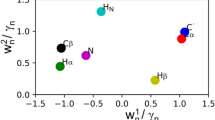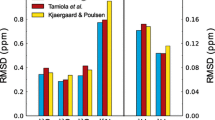Abstract
Applying the chemical shift prediction programs SHIFTX and SHIFTS to a data base of protein structures with known chemical shifts we show that the averaged chemical shifts predicted from the structural ensembles explain better the experimental data than the lowest energy structures. This is in agreement with the fact that proteins in solution occur in multiple conformational states in fast exchange on the chemical shift time scale. However, in contrast to the real conditions in solution at ambient temperatures, the standard NMR structural calculation methods as well chemical shift prediction methods are optimized to predict the lowest energy ground state structure that is only weakly populated at physiological temperatures. An analysis of the data shows that a chemical shift prediction can be used as measure to define the minimum size of the structural bundle required for a faithful description of the structural ensemble.






Similar content being viewed by others
References
Arun K, Langmead CJ (2004) Large-scale testing of chemical shift prediction algorithms and improved machine learning-based approaches to shift prediction. Computational Systems Bioinformatics Conference (CSB’04) 712–713
Brunger AT (2007) Version 1.2 of the crystallography and NMR system. Nat Protoc 2:2728–2733
Brunger AT, Adams PD, Clore GM, DeLano WL, Gros P, Grosse-Kunstleve RW, Jiang JS, Kuszewski J, Nilges M, Pannu NS, Read RJ, Rice LM, Simonson T, Warren GL (1998) Crystallography & NMR System: a new software suite for macromolecular structure determination. Acta Crystallogr D Biol Crystallogr 54:905–921
Geyer M, Schweins T, Herrmann C, Prisner T, Wittinghofer A, Kalbitzer HR (1996) Conformational transition in p21ras and its complexes with effector protein Raf-RBD and the GTPase activating protein GAP. Biochemistry 35:10308–10320
Hahmann M, Maurer T, Lorenz M, Glaser W, Hengstenberg W, Kalbitzer HR (1998) Structural studies of the Histidine-Containing Phosphocarrier Protein (HPr) from Enterococcus faecalis. Eur J Biochem 252:51–58
Iuga A, Spoerner M, Kalbitzer HR, Brunner E (2004) Solid-state 31P NMR spectroscopy of microcrystals of the Ras protein and its effector loop mutants: comparison of solution and crystal structures. J Mol Biol 342:1033–1040
Jia Z, Vandonselaar M, Hengstenberg W, Quail JW, Delbaere LTJ (1994) The 1.6 Å structure of the histidine containing phosphocarrier protein HPr from Streptococcus faecalis. J Mol Biol 236:1341–1355
Jorgensen WL, Tirado-Rives J (1988) The OPLS force field for proteins. Energy minimizations for crystals of cyclic peptides and crambin. J Am Chem Soc 110:1657–1666
Jorgensen WL, Chandrasekhar J, Madura JD, Impey RW, Klein ML (1983) Comparison of simple potential functions for simulating liquid water. J Chem Phys 79:926–935
Kalbitzer HR, Spoerner M, Ganser P, Hosza C, Kremer W (2009) Fundamental link between folding states and functional states of proteins. J Am Chem Soc 131:16714–16719
Koradi R, Billeter M, Wuthrich K (1996) MOLMOL: a program for display and analysis of macromolecular structures. J Mol Graph 14:51–55
Laskowski RA, Rullmannn JA, MacArthur MW, Kaptein R, Thornton JM (1996) AQUA and PROCHECK-NMR: programs for checking the quality of protein structures solved by NMR. J Biomol NMR 8:477–486
Lehtivarjo J, Hassinen T, Korhonen S-P, Peräkylä M, Laatikainen R (2009) 4D prediction of protein 1H chemical shifts. J Biomol NMR 45:413–426
Linge JP, Williams MA, Spronk CAEM, Bonvin AMJJ, Nilges M (2003) Refinement of protein structures in explicit solvent. Proteins Struct Funct Genet 50:496–506
Maurer T, Meier S, Kachel N, Munte CE, Hasenbein S, Koch B, Hengstenberg W, Kalbitzer HR (2004) High-resolution structure of the histidine-containing phosphocarrier protein (HPr) from Staphylococcus aureus and characterization of its interaction with the bifunctional HPr kinase/phosphorylase. J Bacteriol 186:5906–5918
Meiler J (2003) PROSHIFT: protein chemical shift prediction using artificial neural networks. J Biomol NMR 26:25–37
Neal S, Nip AM, Zhang H, Wishart DS (2003) Rapid and accurate calculation of protein 1H, 13C and 15N chemical shifts. J Biomol NMR 2:215–240
Pai EF, Krengel U, Petsko GA, Goody RS, Kabsch W, Wittinghofer A (1990) Refined crystal structure of the triphosphate conformation of H-Ras p21 at 1.35 Å resolution: implications for the mechanism of GTP hydrolysis. EMBO J 9:2351–2359
Perkins SJ, Johnson LN, Philipps DC, Dwek RA (1977) Conformational changes, dynamics and assignments in 1H NMR studies of proteins using ring current calculations. Hen egg white lysozyme. FEBS Lett 82:17–22
Schumann FH, Riepl H, Maurer T, Gronwald W, Neidig K-P, Kalbitzer HR (2007) Combined chemical shift changes and amino acid specific chemical shift mapping of protein-protein interactions. J Biomol NMR 39:275–289
Shen Y, Bax A (2007) Protein backbone chemical shifts predicted from searching a database for torsion angle and sequence homology. J Biomol NMR 38:289–302
Spoerner M, Herrmann C, Vetter IR, Kalbitzer HR, Wittinghofer A (2001) Dynamic properties of the Ras switch I region and its importance for binding to effectors. Proc Natl Acad Sci 98:4944–4949
Stumber M, Geyer M, Graf R, Kalbitzer HR, Scheffzek K, Haeberlen U (2002) Observation of slow dynamic exchange processes in Ras protein crystals by 31P solid state NMR spectroscopy. J Mol Biol 323:899–907
Wang Y (2004) Secondary structural effects on protein NMR chemical shifts. J Biomol NMR 30:233–244
Wang Y, Jardetzky O (2002) Probability-based protein secondary structure identification using combined NMR chemical-shift data. Protein Sci 11:852–861
Xu XP, Case DA (2001) Automated prediction of 15N, 13Cα, 13Cβ and 13C′ chemical shifts in proteins using a density functional database. J Biomol NMR 21:321–333
Acknowledgments
This work was supported by the Bundesministerium für Bildung und Forschung (BMBF), the Deutsche Forschungsgemeinschaft (DFG), the priority program 760 “Medical Chemistry: molecular ligand–receptor interaction” and the European Union (Extend-NMR, SPINE2).
Author information
Authors and Affiliations
Corresponding author
Rights and permissions
About this article
Cite this article
Baskaran, K., Brunner, K., Munte, C.E. et al. Mapping of protein structural ensembles by chemical shifts. J Biomol NMR 48, 71–83 (2010). https://doi.org/10.1007/s10858-010-9438-4
Received:
Accepted:
Published:
Issue Date:
DOI: https://doi.org/10.1007/s10858-010-9438-4




